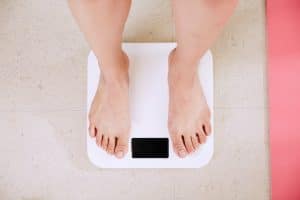
This post will uncover the truth behind the numbers on the scale and help you understand why weight loss alone may not be the best indicator of fat loss. If you’re struggling to lose weight and use a scale to measure your progress, this article is a must-read. I’ll delve into the reasons why the scale can be deceiving and offer you alternative methods to measure your progress accurately.
The Scale’s Limitations
The bathroom scale is a ubiquitous tool for tracking fitness progress, but it has significant limitations, especially for midlife women dealing with menopause-related changes in their bodies. Here’s why:
- Water Weight Fluctuations: Hormonal shifts during menopause can cause water retention, leading to daily fluctuations on the scale. This can be disheartening and misleading when you’re actually making progress losing body fat.
- Muscle vs. Fat: The scale doesn’t differentiate between muscle and fat. Building muscle while losing fat is a common goal, but muscle is denser than fat. So, even if you’re getting leaner, the scale may not budge or could even go up. Another common scenario: cutting calories too much. This is a stress that can certainly lead to weight loss – unfortunately it’s mostly muscle that you’re losing. The scale doesn’t tell the whole story.
- Metabolism Matters: As you age, your metabolism naturally slows down. Weight loss alone might not address the metabolic changes occurring in your body. It’s essential to focus on fat loss rather than just shedding pounds. This is especially true for mid-life women because there is accelerated muscle and bone loss associated with menopause. And less muscle means slower metabolism.
Better Metrics for Fat Loss
Instead of relying solely on the scale, consider these alternative methods for tracking your fat loss journey more accurately:
- Body Composition Analysis: This method measures your body fat percentage, muscle mass, and more. It provides a comprehensive picture of your body’s composition changes. There are several different ways to do this and some methods are more accurate than others. Whatever method you use, be consistent.
- Waist Circumference: Menopause belly fat is often a concern. Measure your waist regularly to track changes in this area, as it’s a good indicator of visceral fat loss. You can measure other areas as well, such as hips and chest.
- How Your Clothes Fit: Pay attention to how your clothes fit. Looser clothing, especially around the waist, can be a strong indicator of fat loss.
- Energy Levels and Well-being: Improved energy, mood, and overall well-being are often the most significant indicators of a successful fitness journey. And good sleep is paramount for losing fat.
- Progress Photos: Take regular photos to visually track your transformation over time. Sometimes, changes that aren’t immediately noticeable on the scale become evident in pictures. Get views from the front, back, and side.
Embrace a Holistic Approach
Losing fat is more than just a number on the scale; it’s about improving your health and well-being. Here are some tips for embracing a holistic approach:
- Nutrition: Focus on a balanced, whole-foods-based diet that supports fat loss and overall health.
- Strength Training: Incorporate strength training into your routine. Building muscle boosts metabolism and aids in fat loss.
- Stress Management: Menopause can be a stressful time. For that matter, trying to lose body fat can be a stress for anyone at any age or life stage. Implement stress-reduction techniques like meditation, yoga, or deep breathing exercises.
- Sleep: Prioritize quality sleep as it plays a crucial role in weight management and overall health.
- NEAT: stands for Non-Exercise Activity Thermogenesis, which basically means – move more and burn calories, just by doing physical activity that isn’t necessarily exercise. Walking the dog, gardening, house chores, etc. Get your butt up and out of the chair and move around every once in awhile.
Remember, weight loss is not the sole measure of success when it comes to losing body fat. By understanding the limitations of the scale and exploring alternative methods to track your progress, such as body composition analysis, taking measurements, and assessing your energy levels and overall well-being, you can gain a more comprehensive understanding of your fat loss journey.
Embrace a holistic approach and celebrate the changes happening in your body beyond what the scale can tell you. Your health and well-being are worth far more than any number on the scale.
Want to get started losing body fat? Start with better eating habits by learning how to plan balanced meals. Sign up for a complimentary 5-day email course below:
[convertkit form=6232009]
